Structural and Rural Transformations and Poverty Reduction in Developing Asian Economies: An International Comparison Among China, the Philippines, and Vietnam
Abstract
1. Introduction
2. Structural and Rural Transformations and Rural Poverty Reduction in China, the Philippines, and Vietnam
2.1. Structural and Rural Transformations in China, the Philippines, and Vietnam
2.2. Rural Poverty Reduction in China, the Philippines, and Vietnam
3. Materials and Methods
3.1. Study Areas
3.2. Indicators of Structural and Rural Transformations
3.3. Methodology and Data
4. Provincial/Regional Structural Transformations and Rural Poverty Incidence in China, the Philippines, and Vietnam
4.1. Provincial Structural Transformation in China, the Philippines, and Vietnam
4.2. Provincial Rural Transformation in China, the Philippines, and Vietnam
4.3. The Trends of Rural Poverty Incidence
5. Results
5.1. Provincial Rural and Structural Transformations and Rural Poverty Reduction in China the Philippines and Vietnam: Based on Graphic Analysis
5.2. Provincial Rural and Structural Transformations and Rural Poverty Reduction in China the Philippines and Vietnam: Based on Regression Analysis
6. Major Institutions, Policies, and Investments Affecting Rural Transformation in China, the Philippines, and Vietnam
7. Concluding Remarks and Policy Implications
Author Contributions
Funding
Data Availability Statement
Acknowledgments
Conflicts of Interest
Abbreviations
| IFAD | International Fund for Agricultural Development |
| FAO | Food and Agriculture Organization of the United Nations |
| GSOV | General Statistic Office of Vietnam |
| PPP | Purchasing Power Parity |
| WDI | World Development Indicators |
| OECD | Organization for Economic Co-operation and Development |
| GDP | Gross Domestic Product |
| IFPRI | International Food Policy Research Institute |
Appendix A
| Country | Region | Province |
|---|---|---|
| China | Middle–lower Yangtze Region | Zhejiang, Jiangsu, Hubei, Hunan, Jiangxi, and Anhui |
| Southwest China | Chongqing, Sichuan, Yunnan, Guizhou, and Guangxi | |
| South China | Fujian and Guangdong | |
| The Philippines | Cordillera Administrative Region, Ilocos, Cagayan Valley, Central Luzon, Calabarzon, Mimaropa, Bicol, Western Visayas, Central Visayas, Eastern Visayas, Zamboanga Peninsula, North Mindanao, Davao, SICCSKSARGEN, Caraga, Autonomous Region in Muslim Mindanao | |
| Vietnam | Red River Delta | Bắc Ninh, Hà Nam, Hưng Yên, Hải Dương, Ninh Bình, Thái Bình, and Vĩnh Phúc |
| Northeast and Northwest Region | Bắc Giang, Bắc Kạn, Hà Giang, Lào Cai, Lạng Sơn, Hòa Bình, Thái Nguyên, Tuyên Quang, and Yên Bái | |
| North Central Coast Region | Hà Tĩnh, Quảng Bình, and Quảng Trị | |
| South Central Coast Region | Bình Định, Phú Yên, Quảng Nam, and Quảng Ngãi | |
| Central Highland and Southeast Region | Bình Phước, Bình Thuận, Ninh Thuận, Tây Ninh, and Gia Lai | |
| Mekong River Delta | An Giang, Bến Tre, Kiên Giang, Long An, Sóc Trăng, Tiền Giang, Trà Vinh, Vĩnh Long, and Đồng Tháp |
| 1 | The regions of the Philippines are similar in size to the provinces of China. As data are only available at the regional level in the Philippines, we use regional data of the Philippines in our analysis. |
| 2 | The provincial rural poverty incidence was higher in the second stage than that in the first stage in China and Vietnam. This is mainly because these two countries raised their national standard of poverty line. |
| 3 | In the process of an inclusive transformation, everyone, without exception, can exercise their economic, social, and political rights, develop their abilities, and take advantage of the opportunities available in their environment [2]. According to IFAD, rural poverty reduction as structural and rural transformation proceed is used as a proxy for inclusion [2]. |
| 4 | Therefore, ST*D1, RT1*D1, and RT2*D1 represent ST, RT1, and RT2 in China during the period of 2011–2017, while ST*D2, RT1*D2, and RT2*D2 represent ST, RT1, and RT2 in Vietnam during the period of 2010–2016. |
References
- Timmer, C. Food security, structural transformation, markets and government policy. Asia Pac. Policy Stud. 2017, 4, 4–19. [Google Scholar] [CrossRef]
- IFAD. Rural Development Report 2016: Fostering Inclusive Rural Transformation; IFAD: Rome, Italy, 2016; pp. 106–124. [Google Scholar]
- Huang, J. Forty years of China’s agricultural development and reform and the way forward in the future. J. Agrotech. Econ. 2018, 3, 4–15. [Google Scholar]
- Huang, J.; Wang, D.; Findlay, C.; Chen, C. Accelerating rural transformation in Asian developing countries. J. Integr. Agric. 2023, 22, 3565–3567. [Google Scholar] [CrossRef]
- NBSC (National Bureau of Statistics of China). China Statistic Yearbook 2020; NBSC: Beijing, China, 2021.
- Hamzah, I. Effective Institutional Arrangement in Rural Development: Malaysia. Master’s Thesis, University of Glasgow, Glasgow, UK, 2010. [Google Scholar]
- Shaari, I. Rural Development and Rural Poverty in Malaysia. In Poverty Amidst Plenty: Research Findings and the Gender Dimension in Malaysia; Ariffin, J., Ed.; Pelanduk Publications: Petaling Jaya, Malaysia, 1994; pp. 26–67. [Google Scholar]
- DOSM (Department of Statistics Malaysia). Yearbook of Statistics Malaysia; DOSM: Kuala Lumpur, Malaysia, 2017.
- World Bank. World Development Indicators; World Bank: Washington, DC, USA, 2015. [Google Scholar]
- GSOV (General Statistics Office of Vietnam). Results of the 2016 Rural, Agricultural and Fishery Census; Statistical Publishing House: Hà Nội, Vietnam, 2017.
- FAO. Agricultural Transformation of Middle-Income Asian Economies: Diversification, Farm Size and Mechanization, by David Dawe; ESA Working Paper No. 15-04; FAO: Rome, Italy, 2015. [Google Scholar]
- Huang, J.; Shi, P. Regional rural and structural transformations and farmer’s income in the past four decades in China. China Agric. Econ. Rev. 2021, 13, 278–301. [Google Scholar] [CrossRef]
- Huang, J. Rural Revitalization: Rural Transformation, Structural Transformation and Government’s Functions. Issues Agric. Econ. 2020, 1, 4–16. [Google Scholar]
- Ramos, C.G.; Estudillo, J.; Sawada, Y.; Otsuka, K. Transformation of the rural economy in the Philippines, 1988–2006. J. Dev. Stud. 2012, 48, 1629–1648. [Google Scholar] [CrossRef]
- Nguyen, M.H.; Dorin, B.; Duteurtre, G. Structural transformation, agriculture and livestock in Vietnam (1970–2015): A multi-scale political economy of an ongoing revolution. In 11ème Journées de Recherche en Sciences Sociales INRA-SFER-CIRAD; SFER: Lyon, France, 2017. [Google Scholar]
- Tarp, F. Growth, Structural Transformation, and Rural Change in Vietnam: A Rising Dragon on the Move; Oxford University Press: Oxford, UK, 2007. [Google Scholar]
- Huang, J. China’s rural transformation and policies: Past experience and future direction. Engineering 2022, 18, 21–26. [Google Scholar] [CrossRef]
- Mat Zin, R. Measuring and Monitoring Poverty and Inequality: The Malaysian Experience; Institute of Southeast Asia Studies: Singapore, 2011. [Google Scholar]
- Bhattacharya, R.; Bhattacharjee, J. Poverty and Inequality in India: Regional Disparities. In Regional Development and Public Policy Challenges in India. India Studies in Business and Economics; Bhattacharya, R., Ed.; Springer: New Delhi, India, 2015. [Google Scholar] [CrossRef]
- NBSC (National Bureau of Statistics of China). China Statistic Yearbook 2017; NBSC: Beijing, China, 2018.
- GSOV (General Statistics Office of Vietnam). Statistical Yearbook of Vietnam; Statistical Publishing House: Hà Nội, Vietnam, 2003.
- World Bank. World Development Indicators; World Bank: Washington, DC, USA, 2023. [Google Scholar]
- Johnston, B.F.; Mellor, J.W. The role of agriculture in economic development. Am. Econ. Rev. 1961, 51, 566–593. [Google Scholar]
- Li, S.; Dong, Y.; Zhang, L.; Liu, C. Off-farm employment and poverty alleviation in rural China. J. Integr. Agric. 2021, 20, 2–10. [Google Scholar] [CrossRef]
- OECD. Review of Agricultural Policies in Vietnam; OECD: Paris, France, 2015. [Google Scholar]
- GSOV (General Statistics Office of Vietnam). Statistical Yearbook of Vietnam; Statistical Publishing House: Hà Nội, Vietnam, 2024.
- Teresa, M.; Sanchez, C. Rural Labor and Rural Non-Agricultural Activities in the Philippines; Discussion Paper Series No. 94-11; Philippine Institute for Development Studies: Quezon City, Philippines, 1994.
- Balisacan, A.M. Agricultural growth, landlessness, off-farm employment and rural poverty in the Philippines. In Proceedings of the 35th Annual, Conference of the Australian Agricultural Economic Society held at the University of New England, Armidale, Australia, 11–14 February 1991. [Google Scholar]
- Briones, R.M. Agricultural Employment and the Rural Household: A Characterization for Selected Provinces in the Philippines; Discussion Paper Series No. 2020-17; Philippine Institute for Development Studies: Quezon City, Philippines, 2020.
- Timmer, P. A World Without Agriculture: The Structural Transformation in Historical Perspective; Wendt Distinguished Lecture; American Enterprise Institute: Washington, DC, USA, 2009. [Google Scholar]
- Farooq, S. The Rural Nonfarm Economy, Livelihood Strategies and Household Welfare in Rural Pakistan; Pakistan Institute of Development Economics (PIDE): Islamabad, Pakistan, 2014. [Google Scholar]
- IFPRI. Global Food Security Report 2019; IFPRI: Washington, DC, USA, 2019; Available online: https://ebrary.ifpri.org/utils/getfile/collection/p15738coll2/id/133129/filename/133348.pdf (accessed on 27 February 2019).
- World Bank. The Philippines Mindanao Jobs Report; World Bank: Washington, DC, USA, 2017. [Google Scholar]
- Huang, J.; Rozelle, S. Technological change: Rediscovering the engine of productivity growth in China’s agricultural economy. J. Dev. Econ. 1996, 49, 337–369. [Google Scholar] [CrossRef]
- Huang, J. Facilitating inclusive rural transformation in the Asian countries. World Food Policy 2018, 4, 31–55. [Google Scholar] [CrossRef]
- USAID. Philippines: Property Rights and Resource Governance; USAID: Washington, DC, USA, 2011.
- World Bank. Philippine Development Report. Creating More and Better Jobs; World Bank: Washington, DC, USA, 2013. [Google Scholar]
- Llanto, G. Infrastructure and regional growth. In The Dynamics of Regional Development: The Philippines in East Asia; Balisacan, A., Hill, H., Eds.; Asian Development Bank Institute; Edward Elgar Publishing: Cheltenham, UK, 2007; pp. 316–344. [Google Scholar]
- Llanto, G. The Impact of Infrastructure on Agricultural Productivity; Philippine Institute for Development Studies: Manila, Philippines, 2012.
- Benedikter, S.; Waibel, G.; Birtel, S.; Tran, B.T. Local Entrepreneurship in Vietnam’s Rural Transformation. A Case Study from the Mekong Delta; Center for Development Research (ZEF): Bonn, Germany; Institute for Socio-Economic Development Studies (CIDS): Can Tho City, Vietnam; Southern Institute of Social Sciences (SISS): Can Tho City, Vietnam, 2013.
- UNDP; AUSAID. The Regional Poverty Assessment; UNDP; AUSAID: Mekong River Region, Vietnam, 2003.
- Vijvereberg, W.P.M.; Haughton, J. Household Enterprises in Vietnam: Survival, Growth, and Living Standards. In Economic Growth, Poverty, and Household Welfare in Vietnam; Glewwe, P., Agrawal, N., Dollar, D., Eds.; World Bank: Washington, DC, USA, 2004. [Google Scholar]
- Oostendorp, R.H.; Trung, T.Q.; Tung, N.T. The Changing Role of Non-Farm Household Enterprises in Vietnam. World Dev. 2009, 37, 632–644. [Google Scholar] [CrossRef]
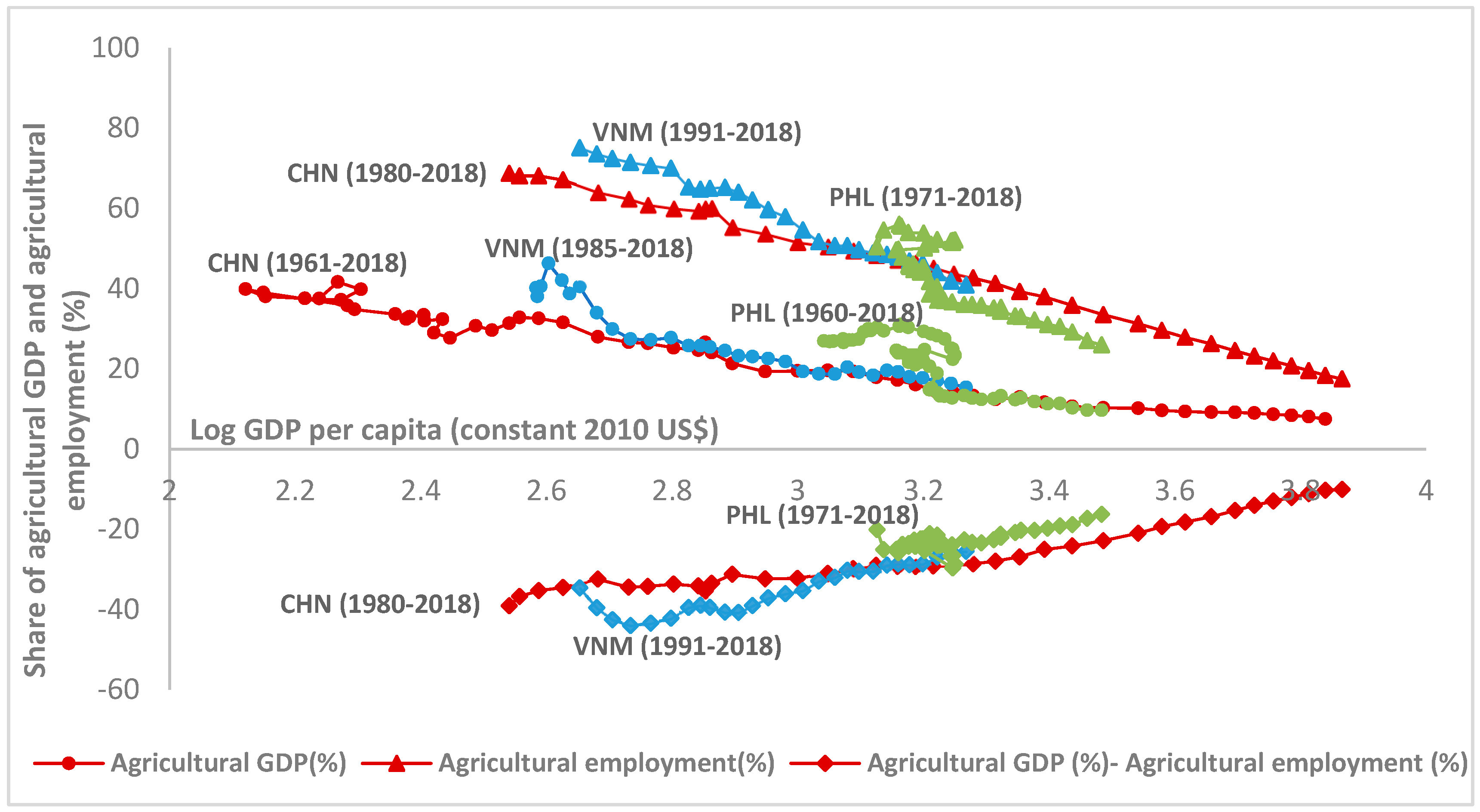
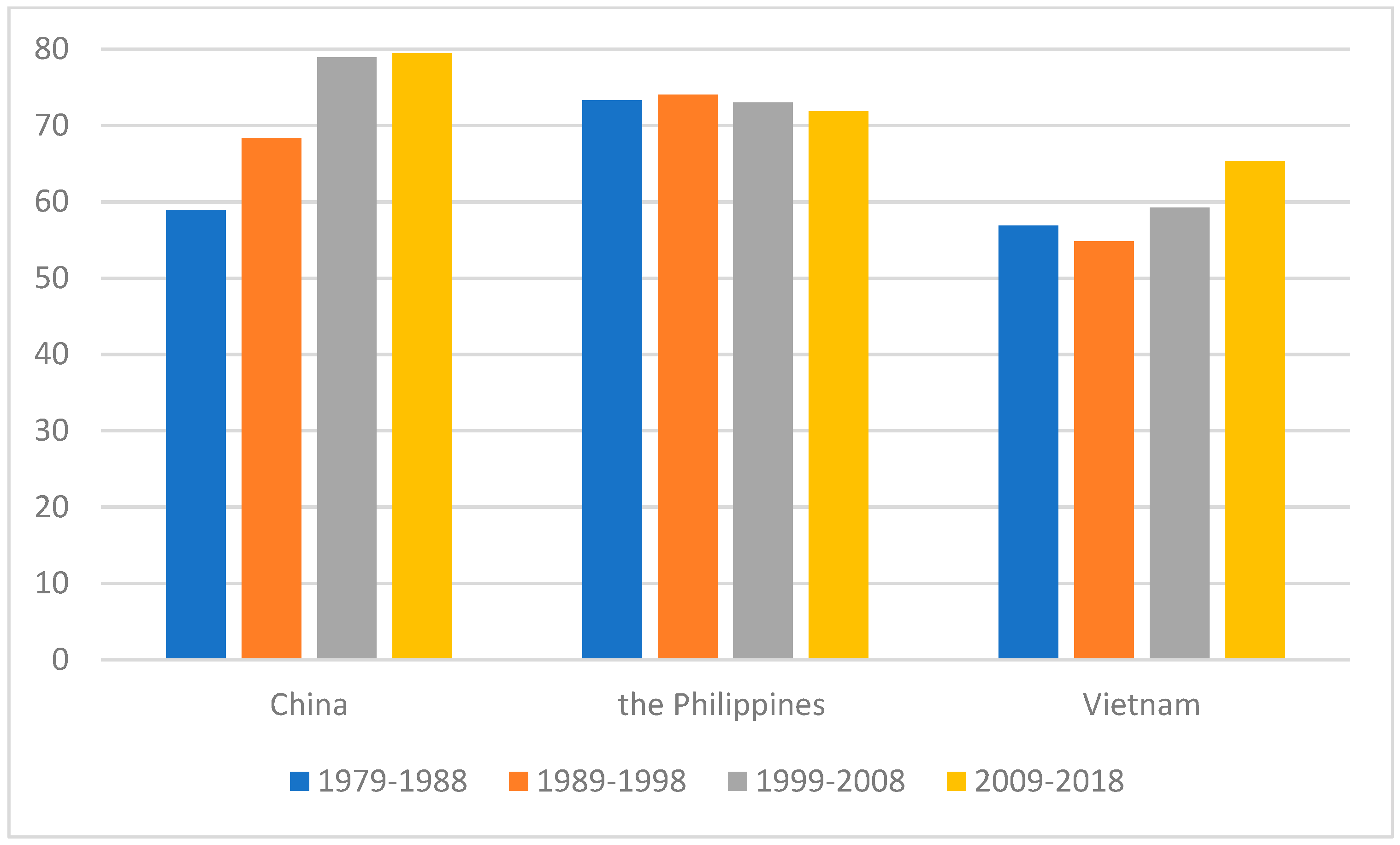
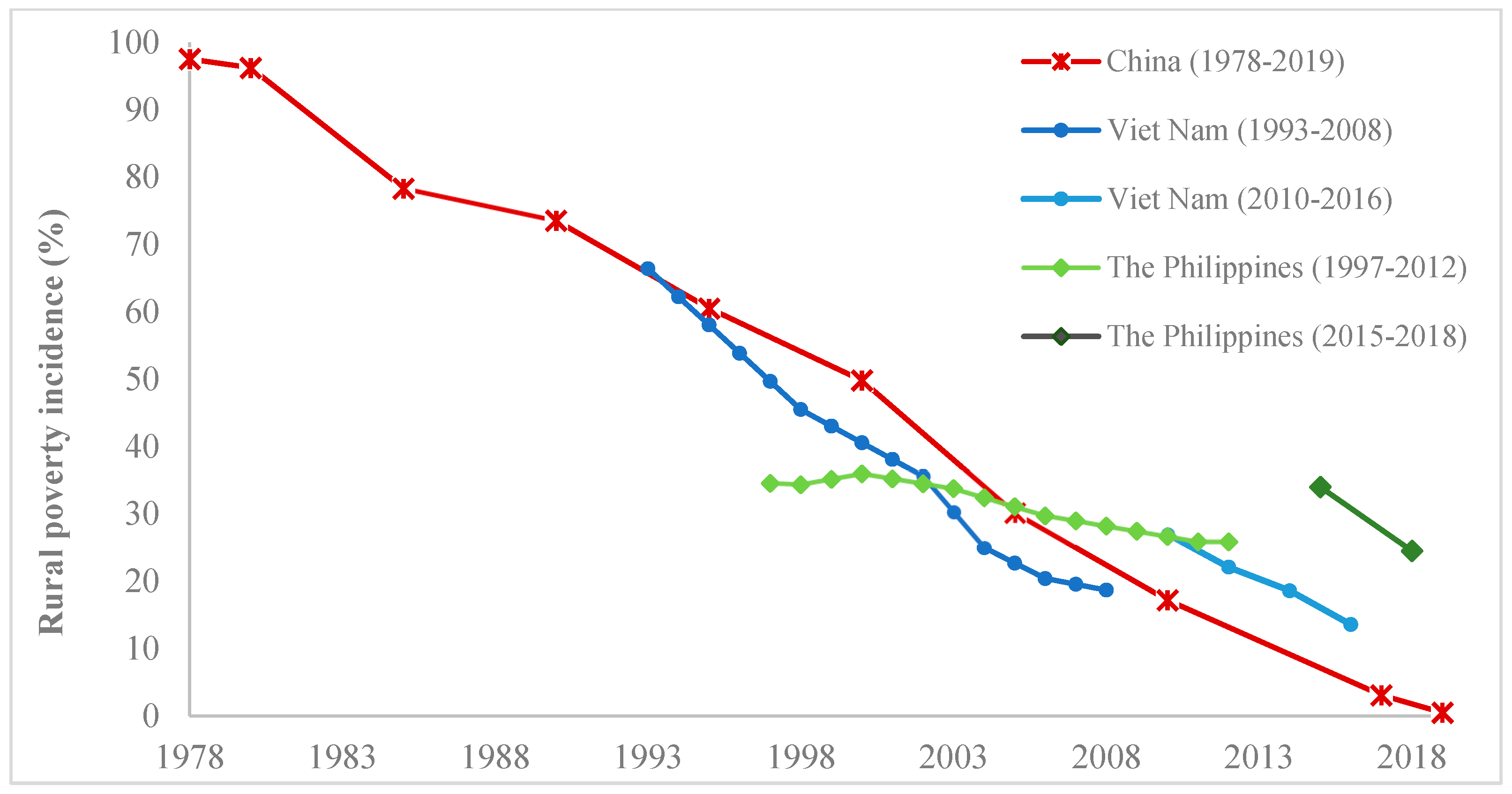
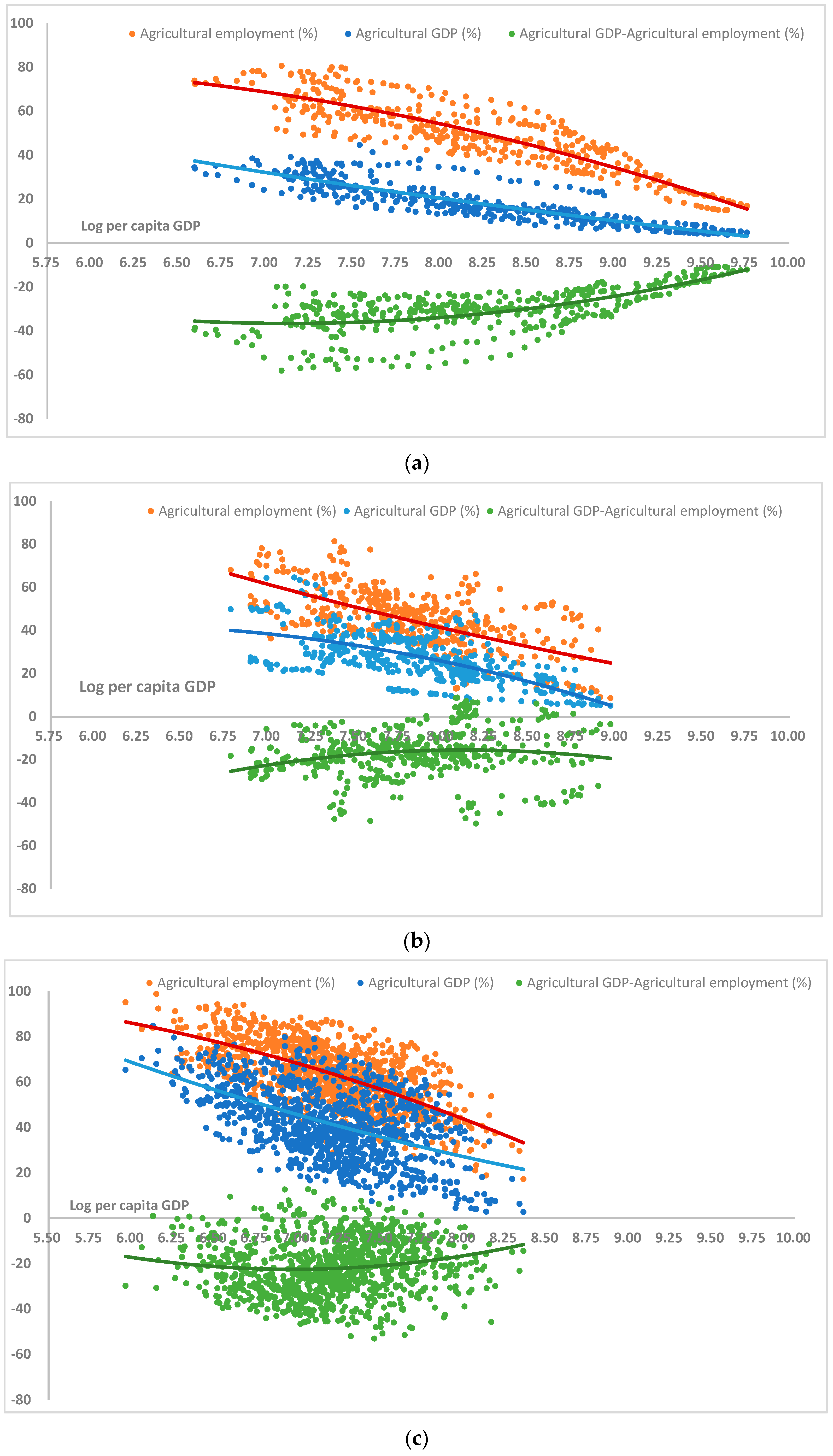
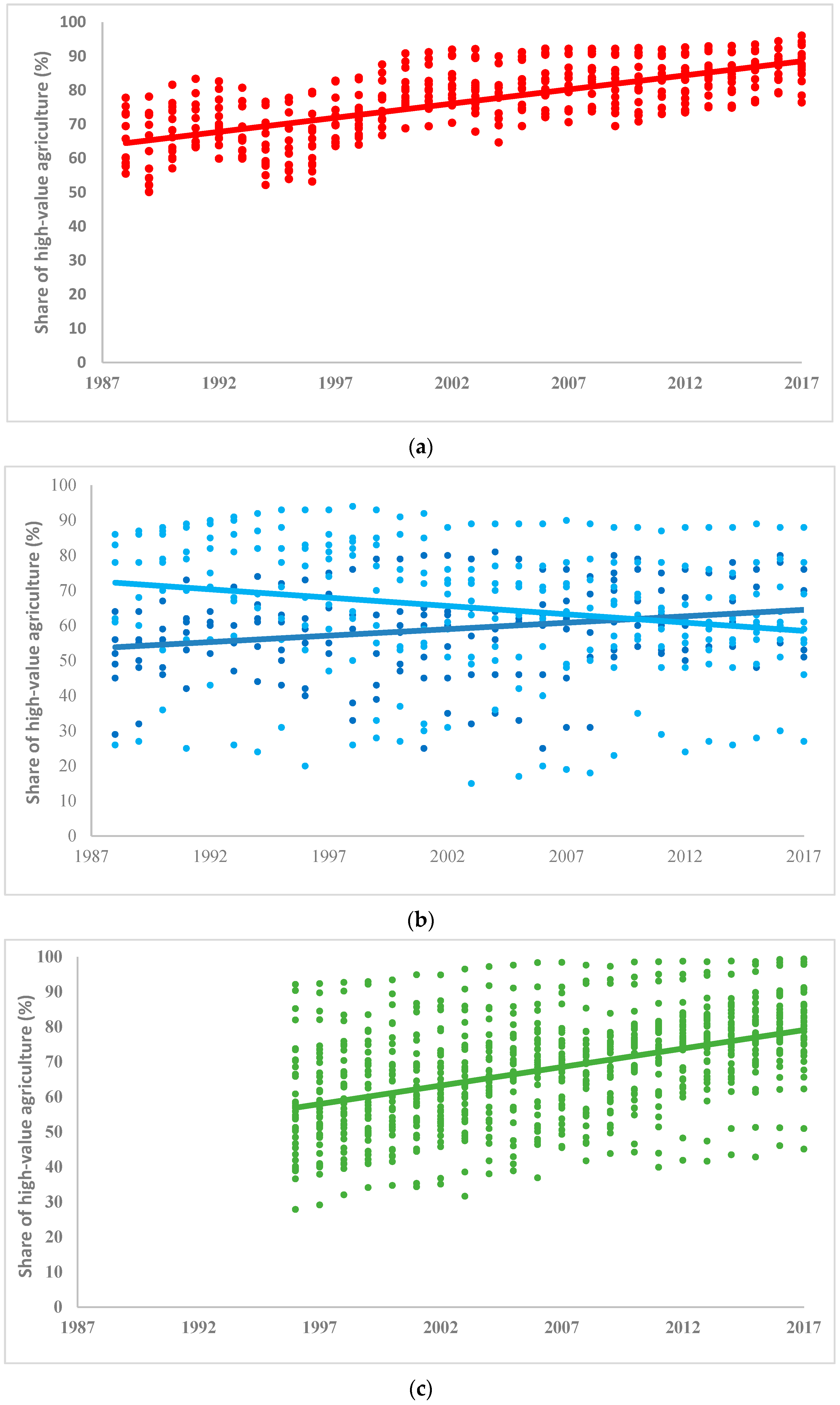
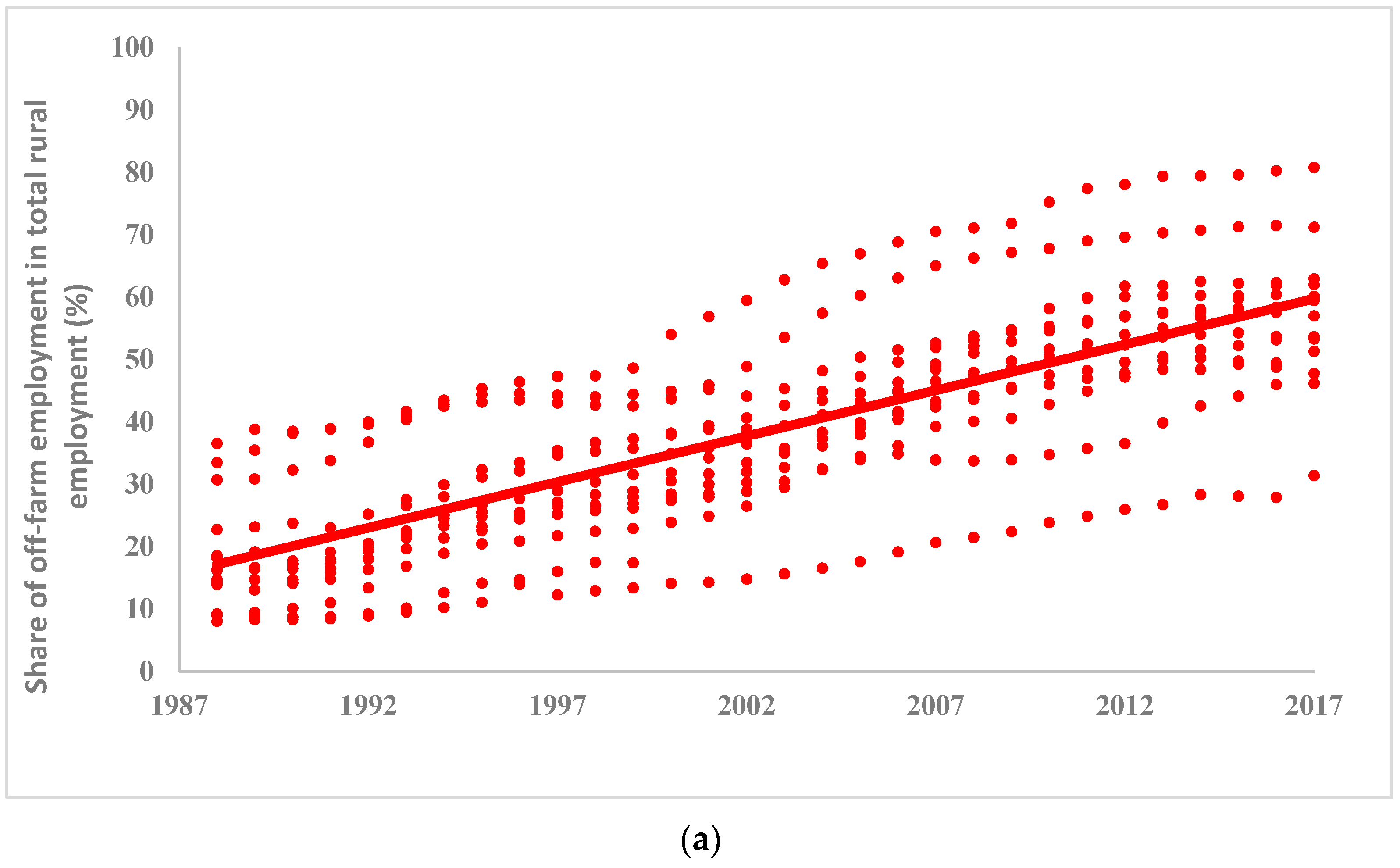


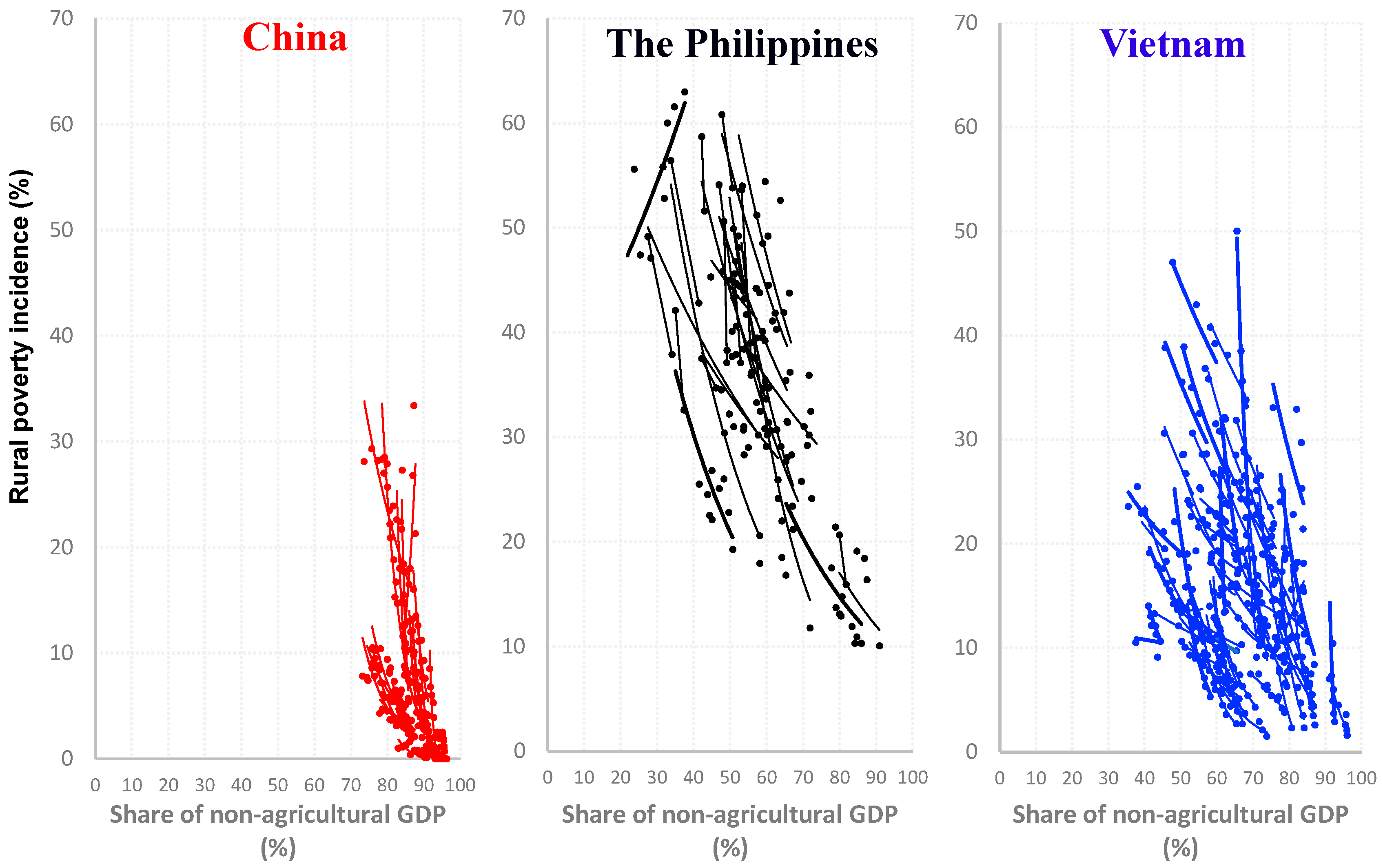
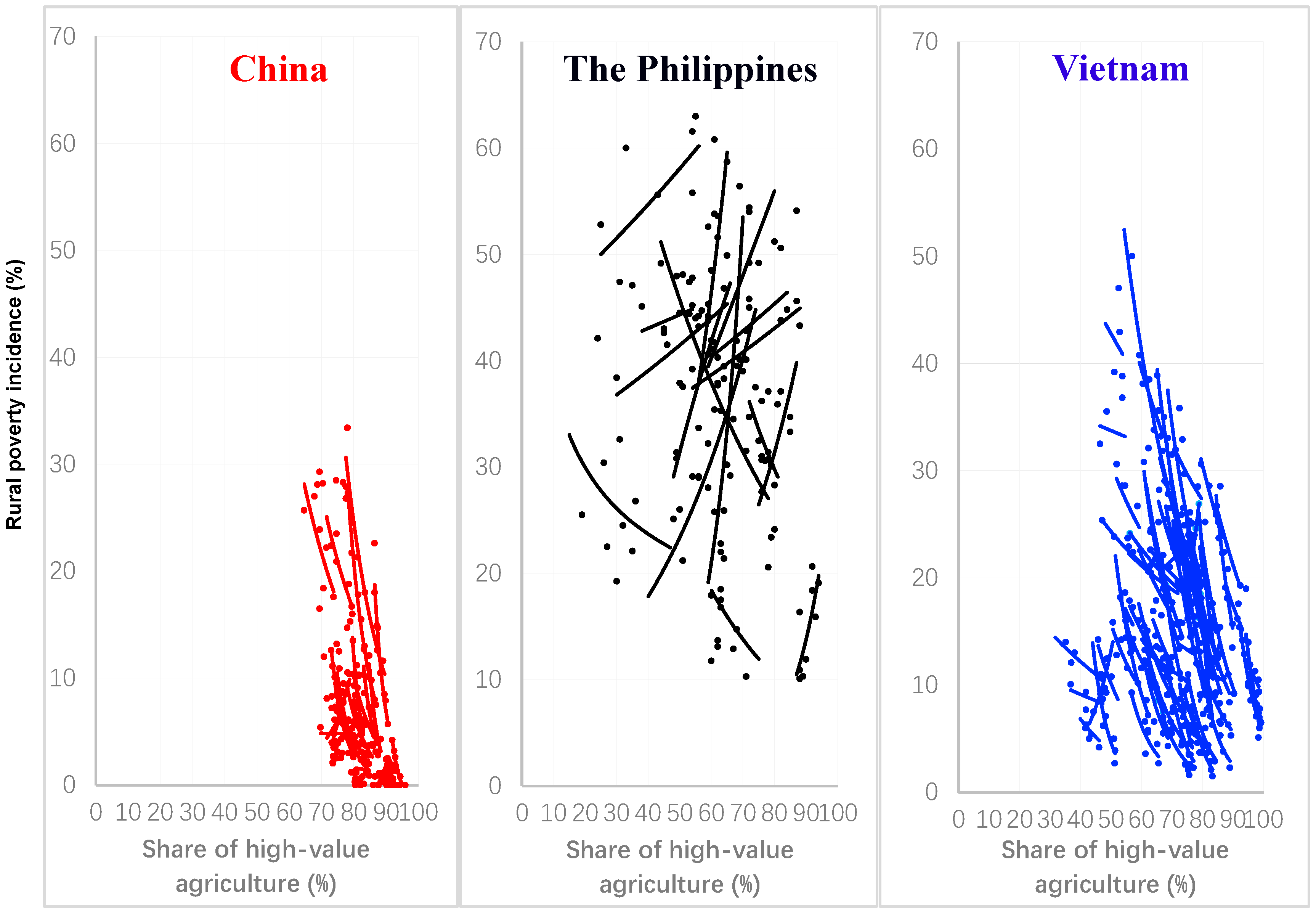
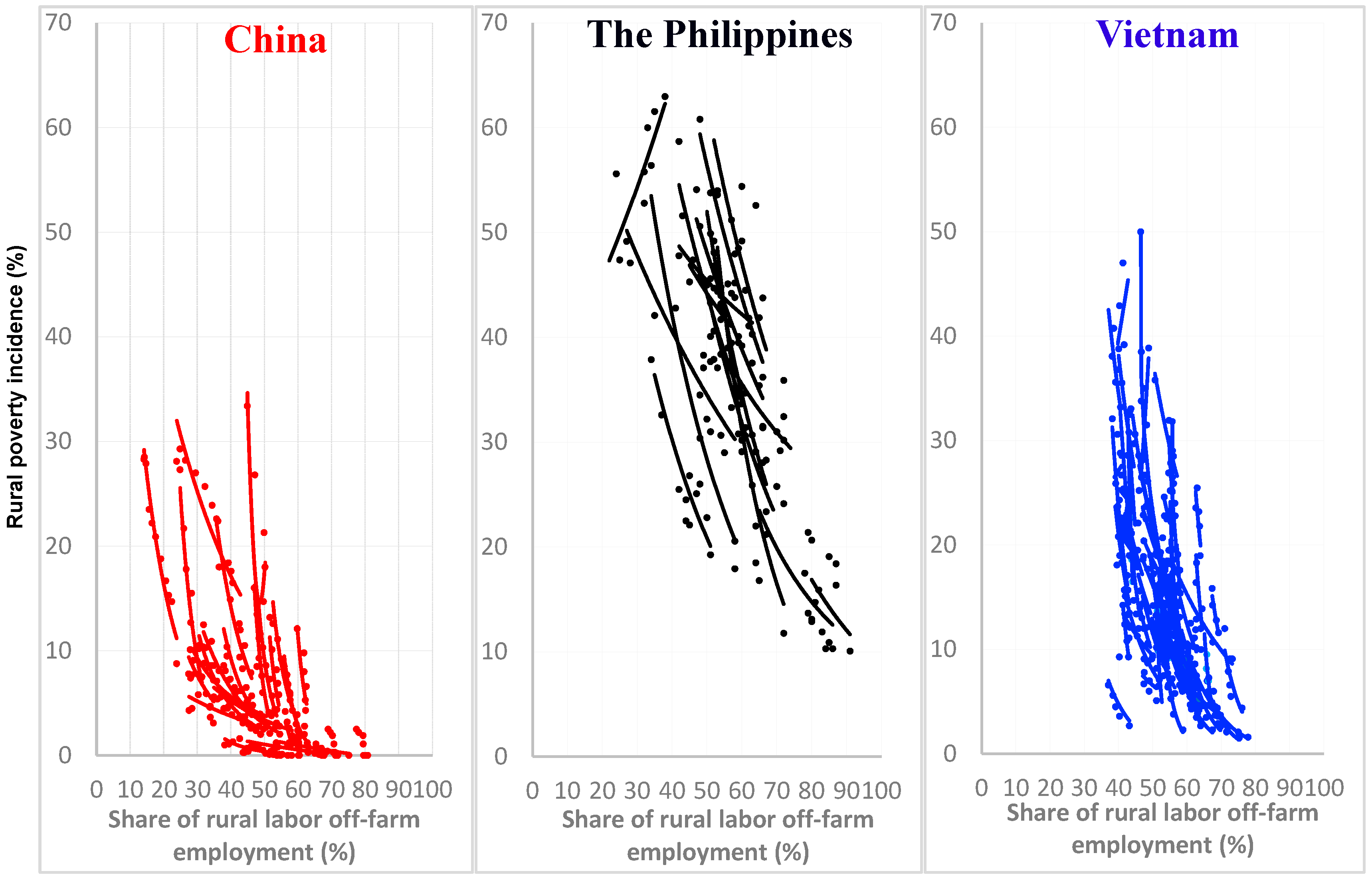
| Added Value Added (Billion USD) | Annual Growth Rate in 1991–2018 (%) | Agricultural Labor Productivity (Added Value per Labor, USD) | Annual Growth Rate in 1991–2018 (%) | |||
|---|---|---|---|---|---|---|
| 1991 | 2018 | 1991 | 2018 | |||
| China | 363 | 1031 | 3.94 | 955 | 5257 | 6.52 |
| Philippines | 18 | 35 | 2.49 | 1732 | 3381 | 2.51 |
| Vietnam | 14 | 38 | 3.77 | 573 | 1629 | 3.95 |
| Dimensions | Indicators | Definitions (Units) |
|---|---|---|
| ST: Structural transformation | Share of non-agricultural GDP | Share of secondary and tertiary industries in total GDP (%) |
| RT: Rural transformation | RT1: Share of high-value agriculture | Share of the output value of non-cereal production in gross output value of agriculture (%) |
| RT2: Share of rural labor off-farm employment | Share of rural labor employed in non-agricultural sectors in total rural employment (%) | |
| Outcome | Rural poverty incidence | Share of rural population below national poverty line (%) |
| China | Vietnam | Philippines | ||||
|---|---|---|---|---|---|---|
| OLS | FE | OLS | FE | OLS | FE | |
| ST | −0.67 *** | −0.64 *** | −0.35 *** | −0.40 *** | −0.53 *** | −0.53 *** |
| (0.09) | (0.07) | (0.05) | (0.05) | (0.10) | (0.12) | |
| ST*D1 | −0.38 *** | −0.36 *** | ||||
| (0.12) | (0.12) | |||||
| ST*D2 | −0.04 | −0.04 | ||||
| (0.04) | (0.04) | |||||
| D1 | 39.24 *** | 36.69 *** | ||||
| (10.47) | (10.56) | |||||
| D2 | 0.44 | 1.11 | ||||
| (2.67) | (2.67) | |||||
| cons | 63.28 *** | 60.69 *** | 40.31 *** | 42.90 *** | 74.60 *** | 74.67 *** |
| (7.36) | (7.68) | (3.26) | (3.17) | (7.94) | (8.48) | |
| Overall R2 | 0.44 | 0.44 | 0.52 | 0.52 | 0.21 | 0.21 |
| Hausman Test | 7.16 * | 7.42 * | 6.09 * | |||
| No. of obs. | 234 | 234 | 370 | 370 | 141 | 141 |
| China | Vietnam | Philippines | ||||
|---|---|---|---|---|---|---|
| OLS | FE | OLS | FE | OLS | FE | |
| RT1 | −0.43 *** | −0.47 *** | −0.30 *** | −0.43 *** | 0.18 *** | 0.16 ** |
| (0.07) | (0.08) | (0.04) | (0.05) | (0.06) | (0.07) | |
| RT1*D1 | −0.10 *** | −0.12 *** | ||||
| (0.07) | (0.07) | |||||
| RT1*D2 | −0.11 *** | −0.15 *** | ||||
| (0.03) | (0.03) | |||||
| RT2 | −0.30 *** | −0.29 *** | −0.44 *** | −0.28 *** | −0.53 *** | −0.55 *** |
| (0.03) | (0.04) | (0.08) | (0.09) | (0.08) | (0.09) | |
| RT2*D1 | −0.02 *** | −0.02 *** | ||||
| (0.04) | (0.03) | |||||
| RT2*D2 | 0.10 | 0.02 | ||||
| (0.05) | (0.04) | |||||
| D1 | 15.86 *** | 18.03 *** | ||||
| (5.52) | (5.52) | |||||
| D2 | 4.04 *** | 8.97 *** | ||||
| (3.44) | (3.43) | |||||
| cons | 54.44 *** | 56.69 *** | 56.09 *** | 62.55 *** | 72.16 *** | 74.58 *** |
| (5.52) | (6.40) | (3.82) | (4.66) | (5.78) | (6.75) | |
| Overall R2 | 0.61 | 0.60 | 0.61 | 0.62 | 0.52 | 0.52 |
| Hausman test | 45.20 *** | 43.98 *** | 43.00 *** | |||
| No. of Obs. | 234 | 234 | 370 | 370 | 141 | 141 |
| China | Vietnam | Philippines | ||||
|---|---|---|---|---|---|---|
| OLS | FE | OLS | FE | OLS | FE | |
| ST | −0.57 *** | −0.60 *** | −0.26 *** | −0.25 *** | −0.53 *** | −0.55 *** |
| (0.07) | (0.08) | (0.05) | (0.05) | (0.11) | (0.14) | |
| ST*D1 | −0.47 *** | −0.47 *** | ||||
| (0.11) | (0.11) | |||||
| ST*D2 | −0.03 | −0.03 | ||||
| (0.04) | (0.03) | |||||
| RT1 | −0.55 *** | −0.62 *** | −0.32 *** | −0.40 *** | −0.02 | −0.03 |
| (0.07) | (0.08) | (0.04) | (0.05) | (0.08) | (0.10) | |
| RT1*D1 | −0.09 | −0.12 ** | ||||
| (0.08) | (0.07) | |||||
| RT1*D2 | −0.14 *** | −0.16 *** | ||||
| (0.03) | (0.03) | |||||
| D1 | 55.71 *** | 58.88 *** | ||||
| (9.68) | (9.57) | |||||
| D2 | 12.51 *** | 14.03 *** | ||||
| (3.24) | (3.66) | |||||
| cons | 99.78 *** | 107.45 *** | 56.09 *** | 60.73 *** | 76.78 *** | 78.27 *** |
| (7.53) | (8.69) | (3.82) | (3.66) | (10.95) | (14.33) | |
| Overall R2 | 0.54 | 0.54 | 0.64 | 0.64 | 0.21 | 0.21 |
| Hausman test | 25.77 *** | 38.72 *** | 20.05 *** | |||
| No. of obs. | 234 | 234 | 370 | 370 | 141 | 141 |
Disclaimer/Publisher’s Note: The statements, opinions and data contained in all publications are solely those of the individual author(s) and contributor(s) and not of MDPI and/or the editor(s). MDPI and/or the editor(s) disclaim responsibility for any injury to people or property resulting from any ideas, methods, instructions or products referred to in the content. |
© 2025 by the authors. Licensee MDPI, Basel, Switzerland. This article is an open access article distributed under the terms and conditions of the Creative Commons Attribution (CC BY) license (https://creativecommons.org/licenses/by/4.0/).
Share and Cite
Chen, Q.; Huang, J.; Sombilla, M.A.; Truong, T. Structural and Rural Transformations and Poverty Reduction in Developing Asian Economies: An International Comparison Among China, the Philippines, and Vietnam. Land 2025, 14, 350. https://doi.org/10.3390/land14020350
Chen Q, Huang J, Sombilla MA, Truong T. Structural and Rural Transformations and Poverty Reduction in Developing Asian Economies: An International Comparison Among China, the Philippines, and Vietnam. Land. 2025; 14(2):350. https://doi.org/10.3390/land14020350
Chicago/Turabian StyleChen, Qiu, Jikun Huang, Mercedita A. Sombilla, and Trang Truong. 2025. "Structural and Rural Transformations and Poverty Reduction in Developing Asian Economies: An International Comparison Among China, the Philippines, and Vietnam" Land 14, no. 2: 350. https://doi.org/10.3390/land14020350
APA StyleChen, Q., Huang, J., Sombilla, M. A., & Truong, T. (2025). Structural and Rural Transformations and Poverty Reduction in Developing Asian Economies: An International Comparison Among China, the Philippines, and Vietnam. Land, 14(2), 350. https://doi.org/10.3390/land14020350






